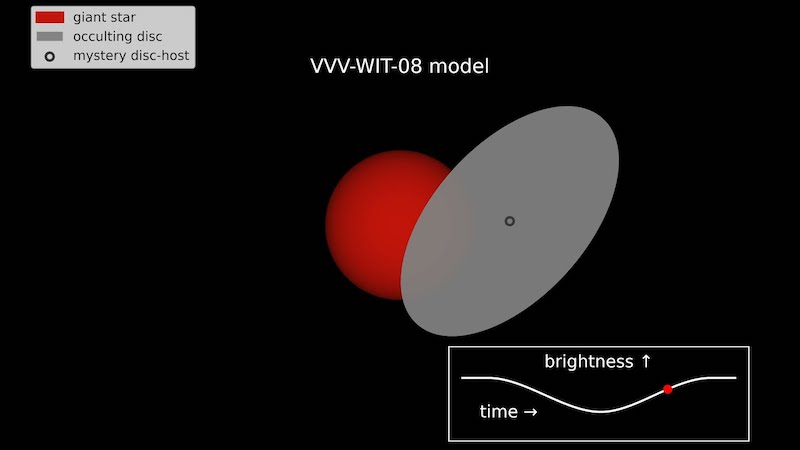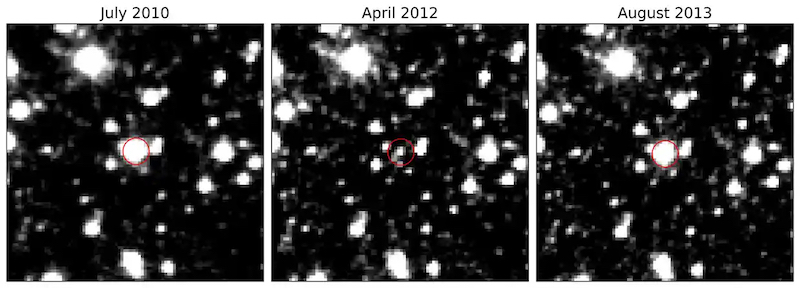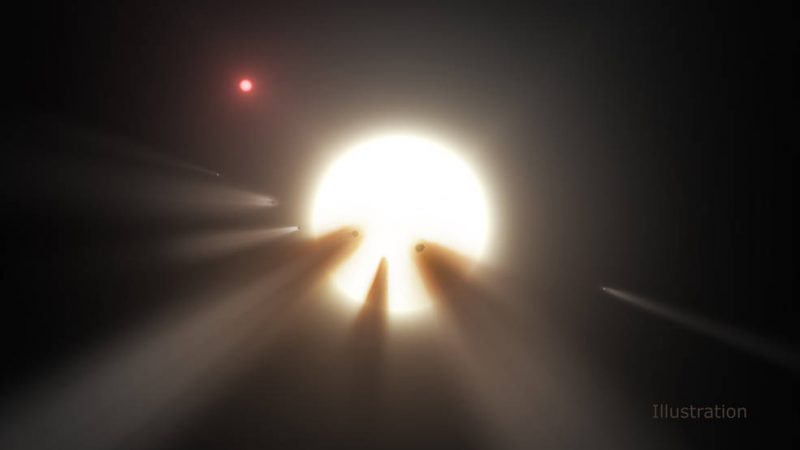
Remember Tabby’s Star? Citizen scientists with the Planet Hunters project spotted it in 2015. Tabby’s Star was dimming rapidly, in weird and unexpected ways. The theories for its unusual behavior ranged from alien megastructures to clouds of dust. That mystery hasn’t been fully solved, but dust does now seem to be the culprit. In June 2021, astronomers released a new study about a new and even bigger mystery (literally). It’s a huge and opaque “something” that dimmed the brightness of a giant star by up to 97% over a period of about 200 days. Even the largest dips in the brightness of Tabby’s Star reached only about 22%. Is it dust again? What else could it be?
The star, VVV-WIT-08, is an evolved giant star, some 100 times larger than our sun. It’s older than our sun, too, about 8 billion years old in contrast to our sun’s 4 1/2 billion years. It lies approximately 25,000 light-years away in the direction of the constellation Sagittarius, toward the dense center of our Milky Way galaxy.
Its minimum brightness happened in April 2012. Scientists still don’t have an explanation.
But they’re still thinking about it. The journal Monthly Notices of the Royal Astronomical Society published a new study about this star on June 11, 2021. See the preprint here.
‘Something’ dims a giant star
It’s a fascinating mystery, since whatever blotted out the star doesn’t seem to have the properties of an ordinary dust cloud. As described in the new paper, whatever it was had a “hard edge” and was virtually completely opaque.
Astronomers first noticed the weird event in data from the VISTA Variables in the Via Lactea (VVV) survey. As lead author Leigh Smith of the University of Cambridge told The Guardian on June 11:
It appeared to come out of nowhere.
He also told National Geographic six days later:
It’s unusual for a star to dim in brightness by this much and for this long.
Another team member, Sergey Koposov of the University of Edinburgh, commented in the scientists’ statement that:
It’s amazing that we just observed a dark, large and elongated object pass between us and the distant star, and we can only speculate what its origin is.


They saw it happen only once
Seeing such a dramatic dimming, with such an unknown and mysterious cause, is both interesting and frustrating for astronomers. They see that the drop in brightness is impressive: 97%! And they’d like to be able to puzzle out how such a dramatic brightness drop could take place. These astronomers used data from the European Space Agency’s Gaia spacecraft and the ground-based survey called OGLE to try to solve the mystery.
But there are many, many possible scenarios suggested by the data. With Tabby’s Star, for example, the dimming differed with different wavelengths, which is compatible with clouds of dust. But with VVV-WIT-08, the consistent dimming across all wavelengths shows that the object was much more opaque and “solid.”
Another oddity was that the observations from Gaia even suggested that the star was moving through space faster than previously thought, almost fast enough to escape the Milky Way.
That doesn’t make sense for a star located in the direction of the galactic bulge, in the middle of our galaxy.
Many theories, but no answers
Astronomers said that – to try to explain the mysterious event – they’ve considered and then rejected many possible theories. The object appeared to be larger than the star itself, but could it have been smaller than thought and closer to Earth? Might it have drifted in front of the star, from our viewpoint, by chance?
That kind of chance alignment, as seen from Earth, would be unlikely, the researchers said. If it happened for this star, shouldn’t it happen for others? That would mean there should be many dark, floating objects in the space of our galaxy. If so, why haven’t we seen them before this? As mentioned in the paper:
We find that an occultation [the hiding of one object by another] due to a chance alignment with the giant star requires an improbably large space density of dark foreground objects. Hence, the occulter [the object doing the hiding] is most likely gravitationally bound to the giant.
Could the dimming have instead originated from the star itself? Stars that dim and then get bright again are common. But giant stars like VVV-WIT-08 don’t tend to drop in brightness by 97%. As noted in the paper:
The behavior of the light curve of VVV-WIT-08 does not correspond to any known intrinsic stellar variability. It is almost certainly an occultation of the giant star.

Could it be a debris disk?
The researchers say the object that caused the dimming is probably gravitionally bound to the star. It might be orbiting the star. But what is it?
The best conventional explanation would likely involve dust. It might be some a huge, dusty debris disk. Such disks are common. They sometimes surround stars, the way that rings surround a planet like Saturn. Maybe the dimming of VVV-WIT-08 was caused by a debris disk. Maybe the disk wasn’t orbiting VVV-WIT-08 itself, but another body that in turn is orbiting VVV-WIT-08. In other words, maybe VVV-WIT-08 has a companion star or planet with a large, dusty debris disk.
Dust is usually easily recognizable, however, as it filters light in a way that allows longer, redder wavelengths to pass through it. The data from VVV-WIT-08 didn’t look like that.
Debris disks also don’t have “hard edges” as such. With dust, you typically see a tapering off at the edges.
Another possibility though is a giant ring system around the orbiting body. Astronomer Jason Wright at Pennsylvania State University noted in National Geographic that Saturn’s rings have well-defined edges. That definition is thanks in part to the gravitational influence of small moonlets that orbit in the gaps between the rings.
This object would likely have to be one giant ring though, since no gaps were observed. The star was seemingly blotted out by one large continuous mass.
If it’s a debris disk, then what’s it orbiting?
Maybe the object hiding the star is a debris disk. But, if so, we still don’t know what the debris disk is orbiting. Main sequence stars, like our sun, and white dwarf stars have been know to have debris disks. But those kinds of disks don’t fit with what’s been observed at VVV-WIT-08.
Or, here’s another dust scenario that doesn’t fully fit, but is still on the table. The researchers considered an orbiting body that is stripping dust off of VVV-WIT-08.

Could it be a black hole?
Another, more exotic possibility is that the orbiting body is a black hole with a dense debris ring around it. Intriguing, although it’s something that hasn’t been seen before. From the paper:
We considered a number of possible astrophysical objects as candidates for the occulter. Debris disks around main sequence stars are too optically thin. While white dwarf debris disks are optically thick, they are too small. Accretion disks around black holes and neutron stars usually emit X-rays, but a black hole fallback disk of the type described by Perna et al. (2014) might plausibly explain the occultation.
‘Blinking giant’ stars
Astronomers also think it’s possible that VVV-WIT-08 might belong to a new class of “blinking giant” stars.
These stars have been observed to be eclipsed by huge disks of dust, although not exactly the same as VVV-WIT-08. The star Epsilon Aurigae is eclipsed every 27 years, but only by about 50%. Another giant star, TYC 2505-672-1, is eclipsed every 69 years. The orbital period for whatever blotted out VVV-WIT-08 is still unknown, but must be at minimum 9 years, since another dimming episode hasn’t been seen yet since 2012.
Philip Lucas from the University of Hertfordshire said in the statement from University of Cambridge:
Occasionally we find variable stars that don’t fit into any established category, which we call ‘what-is-this?’, or ‘WIT’ objects. We really don’t know how these blinking giants came to be. It’s exciting to see such discoveries from VVV after so many years planning and gathering the data.
Giant stars often release material into space, but it’s the specific nature of the material near VVV-WIT-08 that has astronomers so puzzled. As Levesque told National Geographic:
It’s nicely not too bizarre; it’s the sort of thing that you would expect. But dust does not look this neat, and it would certainly imply something very unusual about how that dust is distributed.
If these indeed are a new type of “blinking giant” stars, then astronomers expect to find more of them, according to Smith:
There are certainly more to be found, but the challenge now is in figuring out what the hidden companions are, and how they came to be surrounded by discs, despite orbiting so far from the giant star. In doing so, we might learn something new about how these kinds of systems evolve.
Last, but not least, could it be artificial?
Of course, speculation also includes the possibility of this being an artificial object or objects orbiting the star. Dyson spheres come to mind. Proponents of solar power know that only a tiny fraction of the sun’s total energy strikes the Earth. What if we, as a civilization, could collect all of the sun’s energy? That would require solar power collectors in space, likely in a shell around our star, or around our planet.
If we built such a thing, we would be using some form of Dyson sphere, sometimes referred to as a Dyson shell or megastructure.
Proving the existence of an artificial structure in the vicinity of a distant star would be monumental. It would mean there are advanced civilizations elsewhere in our galaxy.
But, as always, astronomers will tell you we shouldn’t jump to this conclusion, every time we find something strange.
And so the search for answers continues!
Bottom line: Something huge and completely opaque blotted out the giant star VVV-WIT-08 for 200 days, with minimum light occurring in April 2012. Scientists still don’t know for sure what it was. A new study raises more questions than answers.











